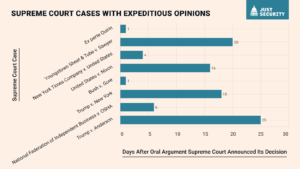SCOTUS To Hear Trump Immunity Argument; Opinion By 5/20 Is Key. 8 Examples Show That SCOTUS CAN Act Quickly
On Thursday, the Supreme Court will hear oral argument in Donald J. Trump v. United States, which addresses the question of whether Trump has presidential immunity for officials acts taken while he was President, which is crucial to this pending 2020 election interference case.
The key, Democracy 21 President Fred Wertheimer writes in an op-ed published today on Just Security, is whether the Supreme Court will act quickly to ensure the 2020 election interference case can be tried before the 2024 election.
“Americans are entitled to know before they vote in November whether former President Donald Trump – the presumptive 2024 Republican presidential nominee – engaged in criminal conduct in his attempt to overturn the 2020 presidential election. He should also be given the opportunity to clear his name,” Wertheimer writes.
“The Supreme Court on several occasions in the past has been willing and able to move very quickly when dealing with questions of historic public importance,” Wertheimer writes.
He continues: “If the nine justices are all playing it straight, and based on more than 80 years of Supreme Court experience with historic cases like this one, we will have a Court decision in Donald J. Trump v. United States no later than May 20,” Wertheimer writes.

Wertheimer discusses eight examples – including three cases since 2020 – that illustrate how the Supreme Court can and has acted quickly on important cases.Each of the eight cases Wertheimer highlights was decided by the Supreme Court from between one day to 25 days following oral argument, with a number including concurring and/or dissenting opinions:
➤ Ex parte Quirin (1942), related to German citizens’ trials during World War II. (1 day from argument to opinion.)
➤ Youngstown Sheet & Tube v. Sawyer (1952), related to efforts by President Truman to take control of the nation’s steel mills, where the Court rejected the President’s takeover. (20 days.)
➤ The Pentagon Papers case (1971), where the Court overturned a government restraining order on The New York Times. (4 days.)
➤ The Watergate Tapes case (1974), where the Court ordered President Nixon to turn over his tapes. (16 days.)
➤ Bush v. Gore (2000), where the Court issued an opinion ending the Florida recount and allowing Bush to win the 2000 election. (1 day.)
➤ The Trump Census case (2020), where the Court dismissed a case related to how non-citizens are used in census data to determine congressional apportionment. (18 days.)
➤ The Biden Covid Vaccine case (2022), where the Court stayed a Biden Administration rule regarding “covid vaccine or test” requirements for workers. (6 days.)
➤ The Colorado Primary Ballot case (2024), where the Court restored Trump to the Colorado primary ballot. (25 days.)
Last month, the Supreme Court issued its decision that benefited Trump in the Colorado primary ballot case just 25 days after oral argument. If that same 25-day timeline is followed in the immunity case, Wertheimer writes, the Supreme Court’s decision in the Trump immunity case should be issued by May 20.
“A decision by the Supreme Court in late May would leave enough time for the district court to begin a trial in August and complete it before the election,” Wertheimer writes.
Wertheimer continues: “Every day after May 20 that goes by without a decision from the Supreme Court makes it more difficult for the district court to conduct a trial before the election. It also raises suspicions that this case is being slow-walked by one or more justices acting in support of Trump’s goal to delay the trial past the election.”